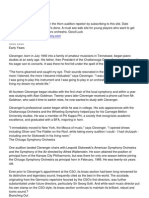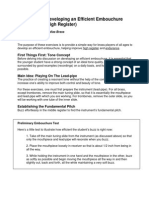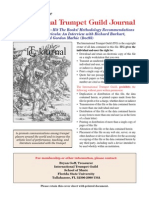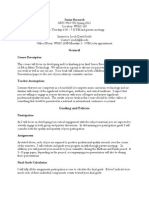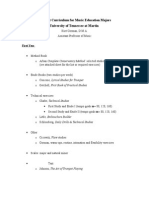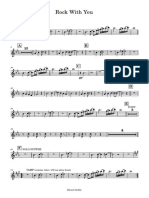Embouchure Horn
Embouchure Horn
Uploaded by
Neri RochaCopyright:
Available Formats
Embouchure Horn
Embouchure Horn
Uploaded by
Neri RochaCopyright
Available Formats
Share this document
Did you find this document useful?
Is this content inappropriate?
Copyright:
Available Formats
Embouchure Horn
Embouchure Horn
Uploaded by
Neri RochaCopyright:
Available Formats
http://www.public.asu.edu/~jqerics/horn_emb.
htm
Embouchure 101
Notes on the basics of a well-formed embouchure
John Ericson
A version of this article was published in the Texas Bandmasters Association Journal 4, no. 2
(December, 2002).
Mouthpiece placement
Wet (moist) or dry lips?
The function of the lip muscles
The lip aperture and the chin
Aperture control and the corners
Mouthpiece pressure and playing high notes
The Jaw and the lips
An exception to the rules: the teardrop upper lip
1. Mouthpiece placement
For as long as horn method books have been written horn teachers have advocated using a
mouthpiece placement of 2/3 upper lip and 1/3 lower lip. Ideally the horn produces a
mellower, richer, darker tone than any of the other brass instruments. An element of this tonal
color is certainly driven by the embouchure being generally more relaxed and puckered than
the embouchures used on other brass instruments. This slightly more relaxed, puckered
position of the horn embouchure emphasizes the fleshy mound in the center of the upper lip,
and this in turn favors a higher mouthpiece placement.
Besides the darker basic tone production of this setting, a higher proportion of upper lip is also
beneficial in playing the entire range of the horn, which is almost four octaves. Too little upper
lip will not allow for production of the lowest notes of the horn with a full tone without making
major shifts of placement.
The basic setting should be the same in the high, middle, and low ranges of the horn. Often
students don't place the mouthpiece as high as they think that they are actually placing it,
something closer to 50/50 than really 2/3 upper lip. You ideally want the mouthpiece to rest
over the top of the fleshy mound in the center of the upper lip.
The most ideal mouthpiece placement is actually fairly easy to define for most players. One
simply needs to wet their lips, place the mouthpiece on the lips, and let the mouthpiece slide
into that position over the mound of the upper lip. Another way to think of this is to "hang the
mouthpiece on the hook" of the upper lip. Either method accomplishes the same thing and will
almost automatically give a hornist a good, natural mouthpiece placement for the horn, 2/3
upper lip and 1/3 lower lip.
A related question is does the mouthpiece have to be centered left to right? The short answer
is no. The face and teeth may dictate an off center placement, but this is of no real concern if
the player feels comfortable and natural with the placement and can form a good aperture.
There are many fine professional players who have slightly off-center embouchures. But it
should be added that if you play off-center with dry lips you might in fact be forcing the
placement into an unnatural placement. See the following section
2. Wet (moist) or dry lips
Closely related to the topic of mouthpiece placement (above) is that of playing with wet or dry
lips. The eminent horn teacher Philip Farkas in his classic treatise The Art of Brass Playing
estimated that approximately 75% of professional brass players play with wet (or moist) lips,
and I would add that it could be argued that the percentage is even higher among fine horn
players.
The primary advantage of wet lips is that the mouthpiece is free to move around somewhat
and find its best, natural placement on the lips when first placed on the lips. This freedom of
movement is also helpful in making large register changes, as the mouthpiece is not "stuck" in
one position. There is no obvious disadvantage to playing with wet or moist lips for the horn
player.
Playing with wet or moist lips is especially important for the beginner on the horn, as the
mouthpiece will be free to settle into its most natural position over the fleshy mound on the
upper lip. Even for advanced players the topic of lip moisture is very worth considering, as on
dry lips the mouthpiece can easily get stuck in a position that may feel normal but is
nevertheless not necessarily the ideal setting where the tone will be the fullest, where the lips
are free to vibrate in their most natural manner, and where you can play easily in every
register.
Finally, mouthpiece rims plated or made of different materials will feel relatively more or less
slippery. While a silver-plated finish is the most widely used, gold is also popular and some
players prefer plastic or nickel silver. In the old days some players even used raw brass rims,
although this is recognized today as not generally speaking being a good idea for health
reasons. In any event, there is no one ideal material for a mouthpiece rim and each one will
alter your perception of how the rim feels on your lips.
3. The function of the lip muscles
While perhaps an oversimplification, a way to visualize how we form a brass embouchure is to
imagine that there are basically two groups of muscles at work. The first are those muscles
that bring our lips to an extreme pucker, such as would be used to whistle--the muscles around
our lips. The second group are those that bring our lips to a smile--the cheek muscles. Either
group, working primarily by itself, can form a brass embouchure of sorts.
Muscles can only contract or relax. When you pucker the cheek muscles relax while the lips
contract. When you smile the cheek muscles contract while the lips relax. To form a correct
brass embouchure the actions of smiling and puckering must be combined and balanced in a
"tug-of-war." The best horn (and brass) embouchure would be one that finds a balance
between the two extremes; Farkas called this ideal a "puckered smile."
A large problem for brass players in general is often too much smile in the embouchure. This is
a problem because this type of embouchure requires the lips to be pulled thin by the cheek
muscles, and this leaves the lips prone to injury, will add a distinct "edge" to the tone, and cuts
down endurance. A more puckered embouchure is naturally "thicker" in the area where the
mouthpiece makes contact and provides for better endurance and tone.
A bright basic tonal color on the horn is often related to too much "smile" in the embouchure,
and it is not uncommon for this to also creep in when approaching the top register of the horn
in an effort to reach the notes. The corners should remain the same in all registers; if the
corners pull back in the high range this is an issue that should be addressed.
While too much smile is not uncommon, it is very rare to find a player who has too much
"pucker" in their embouchure. But to visualize how to play with the correct balance it can be
useful to intentionally pucker too much. One exercise I have found helpful is to take a pen and
try to hold it straight out with your lips only. You have to pucker and be aware of the puckering
muscles to do this successfully; if you use the muscles that you use to smile the pen will droop.
Avoid a bunched up chin when doing this exercise. The bunchy chin is always a problem if
encountered. See section 4.
A final related point has to do with movement around the lips--the type of movement that you
can see when playing passages of music when looking at your embouchure in the mirror. An
embouchure with less overall movement between notes is better, as it is a more efficient
embouchure. A small amount of movement is not a real problem, but you do want to be aware
of and control large movements around the embouchure and lips as for the most part these
are extraneous movements.
4. The lip aperture and the chin
The formation of the lip aperture is very closely related to the way one uses the cheeks and
lips. Inside the mouthpiece the lips form an opening roughly the shape of the opening of a
bassoon or oboe reed. If the embouchure is in a position that is too puckered or contains too
much of a smile this ideal lip aperture shape will be distorted and tone will suffer.
Ideally, a good lip aperture can be formed without the mouthpiece, in a manner where the air
stream can flow straight out the mouth.
Most often the aperture, if a problem, will be too flat due to either too much smile in the
embouchure or to the chin being bunched up. The chin should be flat--if it is bunched up this is
a sign of a serious embouchure problem that must be corrected. What happens is by bunching
up the chin the embouchure will be too closed down because the aperture is being closed
down from below and loses its proper shape; tone and volume will suffer a great deal with this
type of setting.
Another reason the aperture can become distorted is because of too much lip in the
mouthpiece. Not only does this make the aperture flatter in shape but there is a characteristic
roughness to the tonal color with this embouchure and often a lack of dynamic range. Only a
little extra lip in the mouthpiece is the cause of this clamping condition and can drastically
alter the resulting tonal color. In this situation playing with wet lips and a more open
embouchure can make a great deal of difference on the instrument.
A final reason the aperture can be distorted relates to the structure of the lips themselves. See
section 8 for a further discussion of this topic.
5. Aperture control and the corners
An important issue of playing in general and especially in the high register is aperture control.
Proper aperture control will help not only the high range but will also help with accuracy in
general. The aperture must be smaller in the high register than in the low register, and you
want to practice in a manner that helps you to feel and develop fine aperture control.
One method is to as you play visualize that you are controlling the muscles inside the
mouthpiece, making the aperture smaller from the corners and keeping the same basic shape
playing low and high. Visualize the relative size of the opening of a bassoon and a oboe reed,
holding that basic shape.
As this can be difficult to visualize, a more concrete method of thinking about aperture control,
suggested by Fred Fox in his book Essentials of Brass Playing, is to think of the embouchure
being controlled by two sets of muscles. One set is in the corners and is used to produce the
sound "eeeeeeeeee" and the other set is in the middle of the lips and is used to produce the
sound "mmmmmmmmmm." While this is obviously an oversimplification, aperture control
involves the use of these muscles, especially the muscles used to say "mmmmmmmmm."
The corners relate to the aperture in the sense that they need to remain firm and retain the
same basic position playing high or low. A correct position is similar to the "mmmmmmmmm"
position. A horn player should be able to buzz on the mouthpiece to the top notes of their
range; if this is not possible, even if they are able to play the notes on the horn, it is likely that
they have too much smile ("eeeeeeeeee") in the embouchure.
6. Mouthpiece pressure and playing high notes
Moderate mouthpiece pressure is required to play any note on the horn; there must be a seal
between the lips and the mouthpiece. However, especially during the warm-up, it is critical to
not use excessive mouthpiece pressure in the high range. Only by practicing in this manner can
real strength and proper form be developed.
It is a natural and actually an effective approach to use more mouthpiece pressure to reach the
highest notes of the horn. This, however, is NOT the ideal way to reach them. We should
instead focus our attention on the muscles of the lips that are inside the mouthpiece, focusing
the air stream very finely with the aperture, and using plenty of support.
An interesting question to consider is "why does mouthpiece pressure help in reaching the
high notes?" The reason is that the extra pressure makes the lip aperture smaller. Farkas gave
the example of a doughnut, placed under a piece of glass. If the piece of glass is smashed down
on top of the doughnut, the hole in the middle of the squashed doughnut does get smaller.
Our lips are the same as the doughnut in this sense. As we press harder, the aperture gets
smaller. The result is higher notes come out, but with a cost in relation to tone and endurance.
It is critical instead to focus our attention on focusing the aperture by using the muscles of the
lips without using excessive pressure.
In other words, if the top notes don't come out well, you may just need to be patient, practice
consistently, and build up the strength to play high without excessive pressure. Thinking
"mmmmmmmmmm" really does get at what we want, especially when playing passages like
slurred arpeggios.
There is one final pressure related point that must be addressed as well; lateral pressure. This
type of pressure is basically only an issue for horn and tuba players, as these instruments
(typically) rest on the lap. Lateral pressure is a type of mouthpiece pressure that forces the
mouthpiece up, down, or to the side. This is type of pressure is just as undesirable as straight
pressure because it cuts endurance and thins the tone by forcing the lip aperture out of its
proper, natural shape. This pulling or pushing most often occurs when reaching for the highest
notes on the horn.
Besides focusing on the aperture, for hornists an effective way to work on a lateral pressure
problem is to practice standing, as it is more difficult to apply lateral pressure with the horn off
the leg. Lateral pressure can also be very obvious when trying a new leadpipe that is only
taped to the horn--practicing with a taped on leadpipe is a practical exercise to at least be
more aware of the problem.
7. The jaw and the lips
The jaw is too often ignored as an element in forming a high brass embouchure. The
placement of the jaw is very important. The reason this is critical is that the placement of the
jaw relates to the way the lips are used.
For the majority of horn players the jaw MUST be pushed forward somewhat from its normal
position at rest, so that the teeth are in line with each other (up and down), as though you
were biting a sandwich (but not, however, pushed out beyond being even with the upper
teeth). Another easy way to visualize this concept is to imagine spitting a watermelon seed
out. You will not roll the lips over one another--the jaw will come forward a bit in a very
natural way.
A common fault seen in less accomplished horn players is that the lower lip is rolled over the
bottom teeth, and the jaw is not pushed forward. This type of embouchure is for most players
problematic.
An easy exercise to check the jaw placement is the following: form an embouchure without
the mouthpiece and blow. The air stream should go out at the angle of the instrument--nearly
straight forward--not at a steep angle down the chin.
Most sources on brass pedagogy agree that an embouchure where the lower lip is rolled over
the lower teeth and the air stream flows at a sharp angle down the chin is not a well-formed
embouchure. Blowing forward and down the center of the mouthpiece is the ideal.
The angle of the mouthpiece has a distinct relation to the jaw position. As a general rule you
should feel that the mouthpiece pressure is basically the same on the upper and lower lips. A
little more pressure on the lower lip is of no real concern and can be a part of a well-formed
embouchure (some teachers even recommend this), but more pressure on the upper lip could
point toward problems, as this will cut your endurance. It is result of improper jaw position.
Mouthpiece angle is also of special concern if you change the position of your jaw from a
receded to a more square position--the mouthpiece angle may also need to be changed
somewhat as well.
8. An exception to the rules: the teardrop upper lip
The basic geometry of the lips and jaw described above holds up well for most horn players.
There are some players however for whom this basic set up simply will not work well. A
teardrop upper lip, an upper lip that protrudes somewhat into the mouthpiece and that
even at rest appears to hang down in the middle, like a teardrop, requires a somewhat
modified approach. With this type of embouchure essentially the lip aperture must be formed
so that the air will flow at a downward angle below the teardrop.
With this type of setup you are looking for the same basic aperture shape described in the
previous sections but it that shape will be accomplished on a slightly different plane, directing
the air stream more downward. In relation to this, for the teardrop upper lip to form a
successful horn embouchure you will need to allow the jaw to remain more or less in its
natural, receded position so that you can form the aperture below the teardrop. The air
stream will in this case be directed more downward and the horn angled more downward as
well so that mouthpiece pressure is even on both lips.
This type of set up may also work for players where this is not an issue. It is probably not the
ideal, but at the same time it is not something to change if all the major aspects of playing the
horn are working for an individual player. This is also to say, there is no one-size-fits-all horn
embouchure setup; a square setup that directs the air stream forward is desirable for most
players, but for some this setup is simply unworkable as the upper lip will in fact obstruct the
aperture in this type of embouchure setup. If you in fact fall into this category, be sure to
practice at the full range of dynamics and be conscious to make the best aperture shape and
tone possible.
Copyright John Ericson. All rights reserved.
You might also like
- Sing Sing Sing - FULL Big Band - Andrew SistersDocument51 pagesSing Sing Sing - FULL Big Band - Andrew SistersTony LingNo ratings yet
- Boston Crusaders - Brass Technique GuideDocument2 pagesBoston Crusaders - Brass Technique GuideChristian RiveraNo ratings yet
- GeralDocument11 pagesGeralNeri RochaNo ratings yet
- Sir DukeDocument17 pagesSir DukeDiegoCassarino100% (4)
- Method For High-Horn and Low-Horn by Louis-François DaupratDocument20 pagesMethod For High-Horn and Low-Horn by Louis-François Daupratstudio406100% (1)
- A Horn Player's Study GuideDocument24 pagesA Horn Player's Study GuideNeri Rocha100% (2)
- Trevor Jones - Merlin - 3 One Last TrickDocument8 pagesTrevor Jones - Merlin - 3 One Last TrickCharlotte DateNo ratings yet
- Horn Ped 1Document3 pagesHorn Ped 1api-266767873No ratings yet
- Pedagogy 2Document5 pagesPedagogy 2api-372569859No ratings yet
- First Lessons On HornDocument4 pagesFirst Lessons On HornkeeganNo ratings yet
- Breathing Exercises For Wind Players: by Scott RushDocument4 pagesBreathing Exercises For Wind Players: by Scott RushathreyaaNo ratings yet
- Teaching Brass Instruments: How Are They Alike? Sound ProductionDocument14 pagesTeaching Brass Instruments: How Are They Alike? Sound ProductionHugo PONo ratings yet
- Brass Methods Final Project CompressedDocument18 pagesBrass Methods Final Project Compressedapi-510692327No ratings yet
- A Guide To Practicing Tuba and Euphonium PDFDocument6 pagesA Guide To Practicing Tuba and Euphonium PDFMiqueltubaNo ratings yet
- First Lessons On: by Harvey Phillips and Roger RoccoDocument4 pagesFirst Lessons On: by Harvey Phillips and Roger Roccoapi-429126109No ratings yet
- TONY HALSTEAD Horn-Practice MethodDocument11 pagesTONY HALSTEAD Horn-Practice MethodGaspare BalconiNo ratings yet
- TubaClinic PDFDocument16 pagesTubaClinic PDFRafael Cristancho100% (1)
- James Boldin - Horn Maintenance and RepairDocument1 pageJames Boldin - Horn Maintenance and RepairJuan Andrés SilvaNo ratings yet
- Trombone Educator Guide 1Document5 pagesTrombone Educator Guide 1api-532840947No ratings yet
- Dale Clevenger, Orchestral Horn ExcerptsDocument2 pagesDale Clevenger, Orchestral Horn Excerptspaxaxe9No ratings yet
- Method BooksDocument6 pagesMethod BooksBrodyNo ratings yet
- How To Choose A Tuba MouthpieceDocument2 pagesHow To Choose A Tuba Mouthpieceapi-425284294No ratings yet
- James Boldin - Stopped and Muted Horn A Guide For DirectorsDocument10 pagesJames Boldin - Stopped and Muted Horn A Guide For DirectorsJuan Andrés SilvaNo ratings yet
- Alexandra ZacharellaDocument16 pagesAlexandra ZacharellaJacob RosalesNo ratings yet
- MUS 189: Low Brass Methods Dr. Micah Everett, InstructorDocument8 pagesMUS 189: Low Brass Methods Dr. Micah Everett, InstructorIvan OVNo ratings yet
- Back To Basics For Trombone: James L. EllisDocument16 pagesBack To Basics For Trombone: James L. EllisPoompob Anantarak100% (1)
- Trom Perfrom 2Document5 pagesTrom Perfrom 2api-478100074100% (1)
- Daily Routines Student Horn SampleDocument8 pagesDaily Routines Student Horn SampleGaspare BalconiNo ratings yet
- Trumpet Mechanics 1 2014Document23 pagesTrumpet Mechanics 1 2014Roberto E. MencíaNo ratings yet
- Embouchure Technique: Awareness of The Variables..Document9 pagesEmbouchure Technique: Awareness of The Variables..André ChiomentoNo ratings yet
- PDF Band MusicDocument78 pagesPDF Band Musicraul martinez100% (1)
- Horn MouthpiecesDocument9 pagesHorn MouthpiecesJeremy SmithNo ratings yet
- Wendel RideDocument3 pagesWendel RidemanbrassbandNo ratings yet
- Natural HornDocument3 pagesNatural HornroroNo ratings yet
- Horn Ensmeble - MatlickDocument6 pagesHorn Ensmeble - Matlickapi-478048548No ratings yet
- Articulation On The HornDocument2 pagesArticulation On The HornWayne LuNo ratings yet
- EmbouchureDocument32 pagesEmbouchureJeremy SmithNo ratings yet
- French Horn Transposition Reference ChartDocument1 pageFrench Horn Transposition Reference ChartAnonymous fGZ7y3No ratings yet
- Brass Fundamentals: Rimando, Madel C. 9-HarmonyDocument13 pagesBrass Fundamentals: Rimando, Madel C. 9-HarmonyAnonymous bhEtqcYBFNo ratings yet
- Atrombone PDFDocument15 pagesAtrombone PDFliapadesNo ratings yet
- Euphonium MouthpiecesDocument4 pagesEuphonium Mouthpiecesapi-266770330100% (1)
- Marching Band Essential ConceptsDocument4 pagesMarching Band Essential Conceptspianomanshawn9724100% (4)
- Happy Birthday Score PDFDocument2 pagesHappy Birthday Score PDFDaniel JimenezNo ratings yet
- Trumpet Excerpts 2016Document12 pagesTrumpet Excerpts 2016Jacob Morgan100% (1)
- (Trumpet) Trumpet Lessons PDFDocument3 pages(Trumpet) Trumpet Lessons PDFNiko TretyachenkoNo ratings yet
- A French Horn Pedagogue's Professional UnderstandingDocument32 pagesA French Horn Pedagogue's Professional UnderstandingPaula Midão0% (1)
- Basic Trombone Lesson PlanDocument4 pagesBasic Trombone Lesson PlanZack Rogner100% (1)
- A Basic DailyroutineDocument1 pageA Basic DailyroutineManel ArocasNo ratings yet
- Trombone - Band Survival HandbookDocument17 pagesTrombone - Band Survival HandbookaorlandiNo ratings yet
- A Player's Guide To Rotary Valve TrumpetsDocument11 pagesA Player's Guide To Rotary Valve Trumpetsivanwlupoda100% (1)
- Low Brass NotesDocument5 pagesLow Brass NotesJason Crews100% (4)
- Frenchhornwarm Upbook PDFDocument19 pagesFrenchhornwarm Upbook PDFnatrobNo ratings yet
- Levine Trombone ClinicDocument38 pagesLevine Trombone Clinicrj100% (1)
- Horn Syl Lab Us Complete 13Document17 pagesHorn Syl Lab Us Complete 13Jennifer LaiNo ratings yet
- A Guide To The Hughes High Horn Exercises: 1. Harmonic Slurs/Sirens/Bends (A La Francis Orval)Document4 pagesA Guide To The Hughes High Horn Exercises: 1. Harmonic Slurs/Sirens/Bends (A La Francis Orval)luisNo ratings yet
- Flute: Band! Another Fun Way To Make Music Is ToDocument2 pagesFlute: Band! Another Fun Way To Make Music Is Tosofia canoNo ratings yet
- Efficiency Exercises - Rev.2.15.06.for All BrassdocDocument3 pagesEfficiency Exercises - Rev.2.15.06.for All BrassdocChristopher RodriguezNo ratings yet
- HornDocument86 pagesHornAA BBNo ratings yet
- Care Your HornDocument8 pagesCare Your HornAlvaro Suarez VazquezNo ratings yet
- Escalas e ExercíciosDocument37 pagesEscalas e ExercíciosOscar de OliveiraNo ratings yet
- Tuning A Double French HornDocument1 pageTuning A Double French HornDeShaunNo ratings yet
- Building A Better Trumpet Section: Dr. P. Bradley UlrichDocument7 pagesBuilding A Better Trumpet Section: Dr. P. Bradley UlrichNeri Rocha67% (6)
- Boston Symphony OrchestraDocument1 pageBoston Symphony OrchestraNeri RochaNo ratings yet
- Etude ListDocument3 pagesEtude ListNeri RochaNo ratings yet
- Strauss, Richard - Concerto 2 Gliere - Concerto, Opus 91 Kling - Concerto Brillante Weber - ConcertinoDocument4 pagesStrauss, Richard - Concerto 2 Gliere - Concerto, Opus 91 Kling - Concerto Brillante Weber - ConcertinoNeri RochaNo ratings yet
- 3 French Horn and Utility HornDocument1 page3 French Horn and Utility HornNeri RochaNo ratings yet
- Audition Frenchhorn ReqDocument2 pagesAudition Frenchhorn ReqNeri RochaNo ratings yet
- ASU Horn Excerpt ChecklistDocument1 pageASU Horn Excerpt ChecklistNeri RochaNo ratings yet
- 2 French Horn and Utility HornDocument1 page2 French Horn and Utility HornNeri RochaNo ratings yet
- 9512 LibsDocument6 pages9512 LibsNeri Rocha100% (1)
- Brass Warm Up and Technical Studies: Group 1, Long TonesDocument1 pageBrass Warm Up and Technical Studies: Group 1, Long TonesNeri RochaNo ratings yet
- Tuba SyllabusDocument5 pagesTuba SyllabusNeri RochaNo ratings yet
- Senior Research MUS 4910Document3 pagesSenior Research MUS 4910Neri RochaNo ratings yet
- Music Composition SyllabusDocument7 pagesMusic Composition SyllabusNeri RochaNo ratings yet
- Tuba CourseDocument3 pagesTuba CourseNeri RochaNo ratings yet
- University of Arizona SchoolDocument2 pagesUniversity of Arizona SchoolNeri RochaNo ratings yet
- Flute Syl Lab UsDocument12 pagesFlute Syl Lab UsNeri RochaNo ratings yet
- Patricia Spencer's Practice-TechniquesDocument1 pagePatricia Spencer's Practice-TechniquesNeri RochaNo ratings yet
- Trumpet As Scale JazzDocument2 pagesTrumpet As Scale JazzNeri Rocha100% (1)
- Trumpet Curriculum For Music Education Majors University of Tennessee at MartinDocument9 pagesTrumpet Curriculum For Music Education Majors University of Tennessee at MartinNeri RochaNo ratings yet
- Et Tu Danses Danses danses-SCOREDocument2 pagesEt Tu Danses Danses danses-SCOREOakbeanNo ratings yet
- AV2BA901 Original 1889 WebDocument40 pagesAV2BA901 Original 1889 WebYoel Patiño100% (1)
- Toromata - Jazz Band - Alto Sax. 1Document2 pagesToromata - Jazz Band - Alto Sax. 1charrito30No ratings yet
- That's LifeDocument12 pagesThat's LifeCarlos A. DomínguezNo ratings yet
- Selmer Serie SA80 II - Serie IIIDocument2 pagesSelmer Serie SA80 II - Serie IIIAzamat ImanbaevNo ratings yet
- Embraceable You Tenor SaxDocument1 pageEmbraceable You Tenor SaxBoatman BillNo ratings yet
- Guerrers: A Maria Esteve Sanchez Abanderà Guerrers D Ibi Setembre de 2004Document16 pagesGuerrers: A Maria Esteve Sanchez Abanderà Guerrers D Ibi Setembre de 2004CarlosPerezBlancoNo ratings yet
- Persona 3 Reload - Color Your NightDocument40 pagesPersona 3 Reload - Color Your Nightww000038ww12345No ratings yet
- Precious Lord,Take My Hand: Traditional Spiritual 林純純改編20170906Document6 pagesPrecious Lord,Take My Hand: Traditional Spiritual 林純純改編20170906edgar chienNo ratings yet
- Je Suis Dans La Joie EbDocument3 pagesJe Suis Dans La Joie EbdianedecourtivronNo ratings yet
- Artistry For Trumpets-Lennie NiehausDocument22 pagesArtistry For Trumpets-Lennie Niehaussebastiano100% (1)
- SIng Score PDFDocument6 pagesSIng Score PDFEDITOR222No ratings yet
- Quisaz Quisaz Quisaz FulôDocument26 pagesQuisaz Quisaz Quisaz FulôTiago SaxNo ratings yet
- Amor Paz EsperancaDocument26 pagesAmor Paz Esperancarobp2005No ratings yet
- 3 Flute AltoDocument4 pages3 Flute Alto三木和代No ratings yet
- Rock With You Saxophone Ténor 1Document1 pageRock With You Saxophone Ténor 1Lionel Biolley100% (1)
- 297 Jesus, What A Wonderful Child SCOREDocument4 pages297 Jesus, What A Wonderful Child SCOREIan Robbins100% (1)
- E Flat Warm Up FamuDocument3 pagesE Flat Warm Up FamuXingyou DuNo ratings yet
- Vendavais Solo EVE - Tenor Sax 1Document3 pagesVendavais Solo EVE - Tenor Sax 1Everson maciel fernandesNo ratings yet
- Big Band - Nada Alm NevesDocument46 pagesBig Band - Nada Alm NevesmusicaparajesusNo ratings yet
- A La HuacachinaDocument1 pageA La HuacachinaVOUVNo ratings yet
- Danza CaribeDocument22 pagesDanza CaribeRaúlNo ratings yet
- Spring 2017 Concert ProgramDocument3 pagesSpring 2017 Concert ProgramAlex KluttzNo ratings yet
- Casual Suite in EbDocument2 pagesCasual Suite in Ebmonty_bajistaNo ratings yet
- Mindscapes Mostra PDFDocument3 pagesMindscapes Mostra PDFJose SuñerNo ratings yet
- Air For Band - Frank EricksonDocument10 pagesAir For Band - Frank EricksonDaniel RodriguesNo ratings yet
- COUNT YOUR BLESSINGS-Score and PartsDocument28 pagesCOUNT YOUR BLESSINGS-Score and Partsglenodhice2004No ratings yet



















